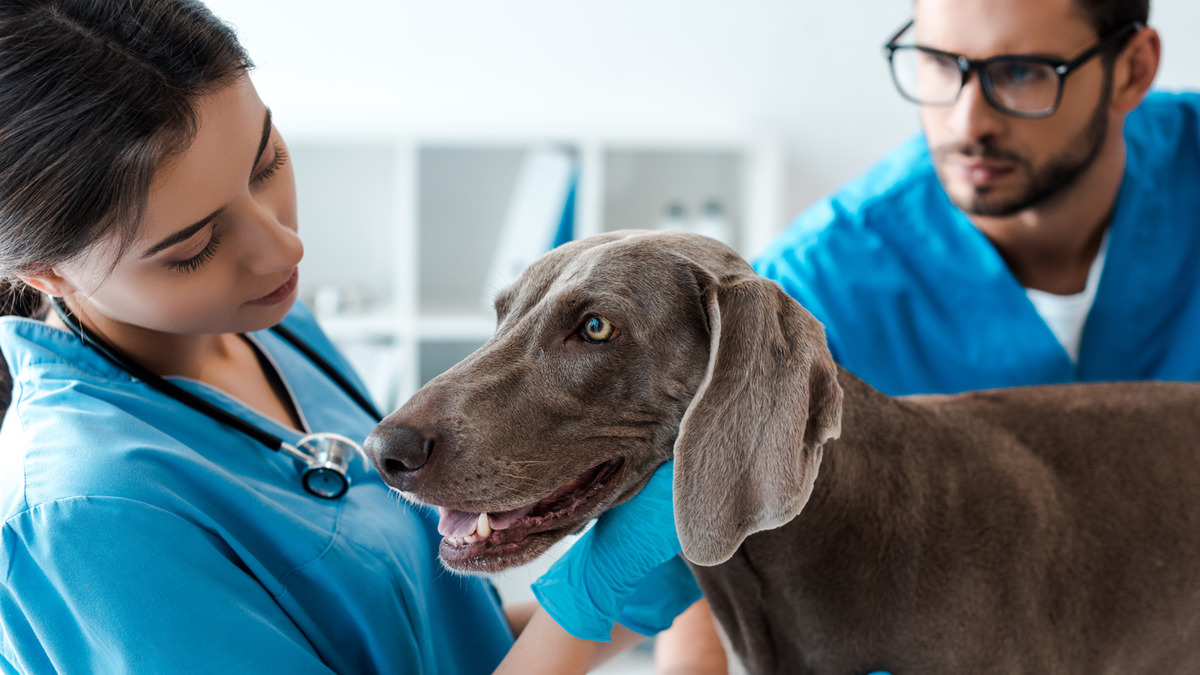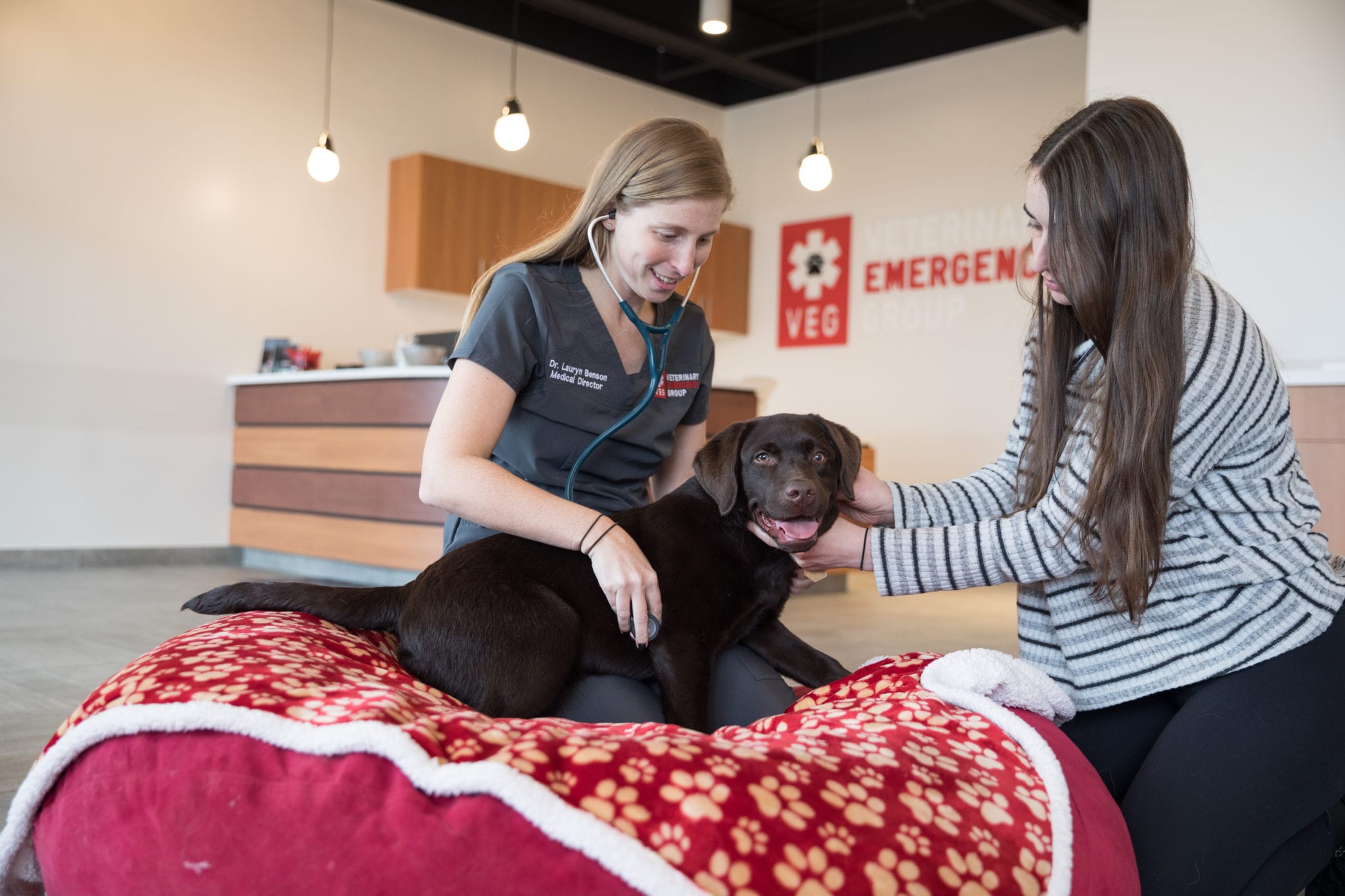Home>Health & Wellness>Common Health Issues>How To Treat Cancer In Dogs


Common Health Issues
How To Treat Cancer In Dogs
Published: February 5, 2024
Learn how to effectively treat cancer in dogs and address common health issues with expert guidance and comprehensive resources. Protect your furry friend's well-being today.
(Many of the links in this article redirect to a specific reviewed product. Your purchase of these products through affiliate links helps to generate commission for Pawsomeoldies.com, at no extra cost. Learn more)
Table of Contents
- Introduction
- Understanding Canine Cancer
- Common Types of Cancer in Dogs
- Signs and Symptoms of Cancer in Dogs
- Diagnosing Cancer in Dogs
- Treatment Options for Canine Cancer
- Surgery
- Chemotherapy
- Radiation Therapy
- Immunotherapy
- Palliative Care
- Nutritional Support
- Alternative and Complementary Therapies
- Monitoring and Follow-Up Care
- Conclusion
Introduction
Cancer is a devastating diagnosis for anyone, and the same holds true for our beloved canine companions. As a pet owner, the thought of your furry friend battling cancer can be overwhelming and distressing. However, it's essential to remember that there are numerous treatment options and supportive measures available to help manage and improve your dog's quality of life during this challenging time.
In this comprehensive guide, we will delve into the world of canine cancer, exploring the common types of cancer that affect dogs, the signs and symptoms to watch out for, the diagnostic process, and the array of treatment options available. From traditional treatments like surgery, chemotherapy, and radiation therapy to alternative and complementary therapies, we will cover the full spectrum of approaches to managing canine cancer.
Understanding the intricacies of cancer in dogs is crucial for pet owners, as it empowers them to make informed decisions about their furry friend's healthcare. By shedding light on the various aspects of canine cancer, we aim to provide valuable insights and guidance to support both pets and their devoted human companions through this challenging journey.
So, let's embark on this enlightening exploration of canine cancer, equipping ourselves with the knowledge and understanding needed to navigate the complexities of this disease and provide the best possible care for our canine companions.
Read more: How To Treat A Dog With Fleas
Understanding Canine Cancer
Canine cancer, much like its human counterpart, involves the abnormal and uncontrolled growth of cells within a dog's body. These cells can form masses or tumors, invade surrounding tissues, and potentially spread to other parts of the body. While the exact cause of cancer in dogs is not always clear, various factors such as genetics, environmental influences, and exposure to carcinogens may contribute to its development.
It's important to recognize that cancer in dogs is not a single disease but rather a complex and diverse group of illnesses. There are numerous types of cancer that can affect dogs, each with its own distinct characteristics and behaviors. From lymphoma and osteosarcoma to mast cell tumors and mammary gland tumors, the spectrum of canine cancer is vast and varied.
Understanding the nature of canine cancer involves delving into the biological mechanisms that drive its progression. Cancer cells in dogs, much like those in humans, exhibit abnormal behaviors such as uncontrolled proliferation, evasion of the immune system, and the ability to promote the growth of blood vessels to sustain their own development. This understanding is crucial in shaping the approach to diagnosis, treatment, and management of cancer in dogs.
Furthermore, it's essential to acknowledge that cancer can affect dogs of any age, breed, or gender. While certain breeds may have a higher predisposition to specific types of cancer, the disease can manifest in any dog, underscoring the importance of vigilance and proactive healthcare measures for all canine companions.
By gaining a deeper understanding of the complexities of canine cancer, pet owners and veterinary professionals can work together to identify potential risk factors, recognize early warning signs, and implement appropriate strategies for prevention, diagnosis, and treatment. This knowledge forms the cornerstone of effective cancer management in dogs, paving the way for improved outcomes and enhanced quality of life for our beloved four-legged friends.
Common Types of Cancer in Dogs
Cancer is a formidable adversary that can manifest in various forms within a dog's body. Understanding the common types of cancer that affect dogs is crucial for early detection, timely intervention, and tailored treatment approaches. Here are some prevalent types of cancer seen in dogs:
-
Lymphoma: Lymphoma is one of the most prevalent cancers in dogs, affecting the lymphatic system and leading to the abnormal proliferation of lymphocytes, a type of white blood cell. This cancer can manifest in various parts of the body, including the lymph nodes, spleen, and bone marrow, and often presents as swollen lymph nodes, lethargy, and weight loss.
-
Osteosarcoma: Osteosarcoma is a highly aggressive bone cancer that commonly affects the limbs of large and giant dog breeds. It is characterized by the rapid proliferation of malignant bone cells, leading to bone destruction, pain, and lameness. Osteosarcoma is known for its propensity to metastasize to other organs, making early detection and intervention critical.
-
Mast Cell Tumors: Mast cell tumors arise from the body's mast cells, which play a role in allergic responses and inflammation. These tumors can occur on the skin or within internal organs and vary in their behavior, ranging from benign to highly malignant. Symptoms may include skin lumps, gastrointestinal issues, and systemic signs of illness.
-
Hemangiosarcoma: Hemangiosarcoma is a highly aggressive cancer that originates in the blood vessels, often affecting the spleen, liver, or heart. This cancer is notorious for its insidious nature, with affected dogs often showing minimal symptoms until the disease reaches an advanced stage. Sudden collapse, weakness, and pale mucous membranes are common signs of hemangiosarcoma.
-
Mammary Gland Tumors: Mammary gland tumors are frequently diagnosed in female dogs, with the risk increasing with age and hormonal influences. These tumors can be benign or malignant and are often detected as palpable lumps in the mammary tissue. Early spaying can significantly reduce the risk of mammary tumors in female dogs.
-
Melanoma: Melanoma is a type of skin cancer that can also affect the mouth and mucous membranes in dogs. While some melanomas are benign, others exhibit aggressive behavior and have the potential to metastasize to other organs. Oral melanomas, in particular, can pose significant challenges due to their invasive nature and potential impact on eating and breathing.
Understanding the characteristics and manifestations of these common types of cancer in dogs is pivotal for pet owners and veterinary professionals. By being vigilant for early warning signs and seeking prompt veterinary care, the impact of these cancers can be mitigated, and tailored treatment strategies can be implemented to improve outcomes and enhance the well-being of our canine companions.
Signs and Symptoms of Cancer in Dogs
Recognizing the signs and symptoms of cancer in dogs is paramount for early detection and timely intervention. While the manifestations of cancer can vary depending on the type and location of the disease, there are several common signs that pet owners should be vigilant for:
-
Unexplained Lumps and Bumps: Palpable masses or lumps on the body, especially those that persist or grow in size, should be promptly evaluated by a veterinarian. These can be indicative of various types of cancer, including mast cell tumors, soft tissue sarcomas, or mammary gland tumors.
-
Abnormal Swelling: Swollen or enlarged lymph nodes, particularly those that do not resolve within a few weeks, can be a sign of lymphoma or other forms of cancer affecting the lymphatic system.
-
Changes in Appetite and Weight Loss: A sudden loss of appetite, unexplained weight loss, or difficulty maintaining a healthy body condition may signal an underlying health issue, including cancer.
-
Lethargy and Weakness: Dogs with cancer may exhibit persistent lethargy, weakness, or reluctance to engage in activities they previously enjoyed. This can be indicative of anemia, pain, or the systemic impact of cancer on the body.
-
Persistent Lameness or Pain: Unexplained lameness, limping, or signs of discomfort, especially in large or giant breed dogs, should prompt a thorough evaluation for conditions such as osteosarcoma or other bone-related cancers.
-
Changes in Bathroom Habits: Difficulty urinating or defecating, blood in the urine or stool, or changes in bowel habits can be indicative of urinary or gastrointestinal cancers.
-
Respiratory Distress: Labored breathing, coughing, or exercise intolerance can be signs of respiratory cancers such as lung tumors or metastatic disease affecting the lungs.
-
Unexplained Bleeding: Any unexplained bleeding from the nose, mouth, or other body openings should be promptly investigated, as it can be associated with cancers such as hemangiosarcoma or oral tumors.
-
Skin Changes: Abnormal skin lesions, sores that do not heal, or changes in the appearance of moles or pigmented areas should be evaluated for potential skin cancers, including melanoma.
-
Digestive Issues: Persistent vomiting, diarrhea, or difficulty swallowing can be indicative of gastrointestinal cancers or tumors affecting the digestive tract.
It's important to note that while these signs and symptoms can raise suspicion of cancer, they are not definitive indicators of the disease. Many other health conditions can present with similar manifestations, underscoring the importance of seeking veterinary evaluation and diagnostic testing for a comprehensive assessment.
By remaining attentive to these potential warning signs and promptly seeking veterinary care when abnormalities are noted, pet owners can play a crucial role in facilitating early detection and initiating appropriate management strategies for cancer in dogs. Early intervention can significantly impact treatment outcomes and the overall well-being of canine companions facing this formidable adversary.
Diagnosing Cancer in Dogs
Diagnosing cancer in dogs involves a multifaceted approach that encompasses clinical evaluation, diagnostic imaging, laboratory tests, and in some cases, tissue biopsy. The process begins with a thorough physical examination by a veterinarian, during which any palpable lumps, abnormal masses, or concerning symptoms are carefully assessed. Additionally, the veterinarian may inquire about the dog's medical history, including any changes in behavior, appetite, or overall well-being.
Diagnostic imaging techniques such as X-rays, ultrasound, and advanced imaging modalities like CT scans or MRI may be employed to visualize internal structures and identify any abnormalities or masses within the body. These imaging studies can provide valuable insights into the location, size, and potential spread of cancerous lesions, aiding in the formulation of a comprehensive diagnostic and treatment plan.
Laboratory tests, including blood work and urinalysis, play a crucial role in the diagnostic process. These tests can reveal abnormalities in blood cell counts, organ function, and metabolic parameters, providing valuable clues about the presence of cancer and its potential impact on the dog's physiological state. Additionally, specialized tests such as cytology or flow cytometry may be utilized to analyze specific cell populations and identify abnormal cellular characteristics associated with cancer.
In cases where a definitive diagnosis is still elusive, tissue biopsy may be recommended to obtain a sample of the abnormal tissue for microscopic examination. This can be achieved through minimally invasive techniques such as fine needle aspiration or more invasive procedures like surgical biopsy, depending on the location and nature of the suspected cancerous lesion. Histopathological analysis of the biopsy sample by a veterinary pathologist can provide a conclusive diagnosis, identify the type and grade of cancer, and guide the selection of appropriate treatment strategies.
Furthermore, advancements in veterinary medicine have led to the development of specialized tests, including molecular diagnostics and genetic profiling, which can offer deeper insights into the molecular characteristics of cancer cells and inform personalized treatment approaches tailored to the individual dog's cancer profile.
The diagnostic journey for canine cancer is a collaborative effort between pet owners and veterinary professionals, with open communication, proactive observation, and timely intervention playing pivotal roles in achieving accurate diagnoses and initiating targeted treatment plans. By leveraging a combination of clinical expertise, advanced diagnostics, and cutting-edge technologies, the veterinary community continues to make significant strides in enhancing the early detection and management of cancer in dogs, ultimately striving to improve outcomes and quality of life for our beloved canine companions.
Read more: What Is The Safest Dental Dog Treat?
Treatment Options for Canine Cancer
The treatment landscape for canine cancer is multifaceted, encompassing a diverse array of therapeutic modalities aimed at managing the disease, alleviating symptoms, and improving the quality of life for affected dogs. The selection of treatment options is influenced by various factors, including the type and stage of cancer, the dog's overall health status, and the pet owner's preferences and resources. Here are some of the primary treatment modalities utilized in the management of canine cancer:
Surgery
Surgical intervention plays a pivotal role in the treatment of canine cancer, particularly in cases where the tumor is localized and amenable to surgical removal. The primary goal of cancer surgery in dogs is to excise the tumor and surrounding affected tissues, with the aim of achieving complete removal and minimizing the risk of recurrence. Depending on the location and extent of the tumor, surgical procedures may range from relatively straightforward excisions to more complex interventions involving the removal of organs or limbs. Additionally, surgical biopsy may be performed to obtain tissue samples for definitive diagnosis and staging of the cancer.
Chemotherapy
Chemotherapy, the use of anti-cancer drugs to inhibit the growth and spread of cancer cells, is a cornerstone of cancer treatment in dogs. While the prospect of chemotherapy may evoke concerns about potential side effects, modern veterinary oncology has made significant strides in tailoring chemotherapy protocols to minimize adverse effects while maximizing therapeutic efficacy. Chemotherapy may be employed as a standalone treatment or in combination with surgery or radiation therapy, offering a comprehensive approach to managing various types of cancer in dogs.
Radiation Therapy
Radiation therapy, utilizing targeted radiation to destroy cancer cells and shrink tumors, is another valuable tool in the arsenal of canine cancer treatment. This modality is particularly beneficial for tumors that are not amenable to surgical removal or in cases where a more localized approach to cancer management is warranted. Advanced techniques such as stereotactic radiation and intensity-modulated radiation therapy (IMRT) enable precise targeting of cancerous lesions while minimizing radiation exposure to surrounding healthy tissues, thereby enhancing treatment efficacy and reducing potential side effects.
Read more: How To Treat Dog’s Anxiety In The Car
Immunotherapy
Immunotherapy, an innovative and rapidly evolving field in veterinary oncology, harnesses the dog's immune system to recognize and combat cancer cells. From immune checkpoint inhibitors to cancer vaccines and adoptive cell therapies, immunotherapy holds promise in augmenting the body's natural defenses against cancer and improving treatment outcomes for dogs with various types of cancer. This approach represents a paradigm shift in cancer treatment, offering novel avenues for personalized and targeted therapies tailored to the individual dog's immune profile and cancer characteristics.
Palliative Care
In cases where a cure may not be achievable, or when the focus shifts to enhancing the dog's comfort and quality of life, palliative care plays a crucial role in the comprehensive management of canine cancer. Palliative treatments, including pain management, nutritional support, and supportive care measures, aim to alleviate symptoms, minimize discomfort, and optimize the well-being of dogs facing advanced or incurable cancers. This holistic approach to care emphasizes the physical, emotional, and psychological aspects of the dog's well-being, providing comfort and dignity throughout the cancer journey.
Nutritional Support
Nutrition plays a fundamental role in supporting dogs undergoing cancer treatment, with tailored dietary strategies aimed at maintaining optimal body condition, supporting immune function, and mitigating the side effects of cancer therapies. Veterinary nutritionists collaborate with oncologists to develop customized nutrition plans that address the unique needs of dogs with cancer, ensuring that they receive essential nutrients, manage gastrointestinal issues, and maintain a healthy appetite throughout the course of treatment.
Alternative and Complementary Therapies
In addition to conventional treatment modalities, a growing body of evidence supports the potential benefits of alternative and complementary therapies in the supportive care of dogs with cancer. Modalities such as acupuncture, herbal medicine, massage therapy, and physical rehabilitation can complement traditional treatments, offering holistic support and enhancing the overall well-being of canine cancer patients. Integrative oncology approaches strive to optimize the synergy between conventional and complementary therapies, providing a comprehensive framework for addressing the multifaceted needs of dogs undergoing cancer treatment.
The landscape of treatment options for canine cancer is continually evolving, driven by ongoing research, technological advancements, and a deepening understanding of cancer biology. By leveraging a combination of conventional and innovative modalities, veterinary oncologists and pet owners collaborate to tailor treatment plans that prioritize the well-being and longevity of dogs facing the challenges of cancer. This comprehensive and integrative approach to cancer management underscores the commitment to providing the best possible care for our beloved canine companions, striving to enhance their quality of life and foster hope in the face of adversity.
Read more: How To Treat My Allergies To Dogs
Surgery
Surgical intervention plays a pivotal role in the treatment of canine cancer, particularly in cases where the tumor is localized and amenable to surgical removal. The primary goal of cancer surgery in dogs is to excise the tumor and surrounding affected tissues, with the aim of achieving complete removal and minimizing the risk of recurrence. Depending on the location and extent of the tumor, surgical procedures may range from relatively straightforward excisions to more complex interventions involving the removal of organs or limbs. Additionally, surgical biopsy may be performed to obtain tissue samples for definitive diagnosis and staging of the cancer.
The decision to pursue surgical treatment for canine cancer involves a comprehensive assessment of various factors, including the type and stage of the cancer, the dog's overall health status, and the potential impact of surgery on the dog's quality of life. In cases where the cancer is confined to a specific area and has not metastasized, surgery offers a curative approach, aiming to eliminate the cancerous growth and prevent its spread to other parts of the body. This localized intervention can be particularly effective for tumors such as mast cell tumors, soft tissue sarcomas, and certain types of skin cancers.
Furthermore, advancements in surgical techniques and perioperative care have contributed to improved outcomes and reduced postoperative complications in dogs undergoing cancer surgery. Minimally invasive procedures, such as laparoscopy and thoracoscopy, offer the benefits of smaller incisions, decreased postoperative pain, and faster recovery times, enhancing the overall experience for canine patients. Additionally, the integration of advanced imaging modalities, such as intraoperative ultrasound and computed tomography (CT), enables precise localization and thorough assessment of cancerous lesions, facilitating targeted surgical interventions and minimizing the impact on surrounding healthy tissues.
Postoperative care and monitoring are integral components of the surgical management of canine cancer. Close collaboration between veterinary surgeons and oncologists ensures that comprehensive postoperative care plans are implemented, encompassing pain management, wound care, and tailored rehabilitation strategies to support the dog's recovery and overall well-being. Additionally, regular follow-up evaluations and imaging studies may be recommended to monitor for any signs of cancer recurrence or metastasis, enabling timely intervention if needed.
In summary, surgery stands as a cornerstone of the multifaceted approach to managing canine cancer, offering a curative or palliative avenue for addressing localized tumors and enhancing the overall quality of life for affected dogs. Through the integration of advanced surgical techniques, personalized care plans, and a commitment to optimizing outcomes, veterinary professionals strive to provide compassionate and effective surgical interventions that uphold the well-being and longevity of our beloved canine companions.
Chemotherapy
Chemotherapy, a cornerstone of cancer treatment in dogs, involves the administration of anti-cancer drugs to impede the growth and spread of malignant cells. While the prospect of chemotherapy may evoke concerns about potential side effects, modern veterinary oncology has made significant strides in tailoring chemotherapy protocols to minimize adverse effects while maximizing therapeutic efficacy.
The decision to pursue chemotherapy for canine cancer is informed by various factors, including the type and stage of the cancer, the dog's overall health status, and the potential impact of chemotherapy on the dog's quality of life. Chemotherapy may be employed as a standalone treatment or in combination with surgery or radiation therapy, offering a comprehensive approach to managing various types of cancer in dogs.
The selection of chemotherapy drugs and treatment regimens is guided by the specific characteristics of the dog's cancer, with the aim of achieving optimal therapeutic outcomes while mitigating potential side effects. Veterinary oncologists carefully assess factors such as the cancer type, tumor size, potential for metastasis, and the dog's individual tolerance to chemotherapy agents, tailoring treatment plans to address the unique needs of each canine patient.
Modern advancements in veterinary oncology have led to the development of novel chemotherapy agents and treatment protocols that prioritize both efficacy and safety. From targeted therapies that focus on specific molecular pathways driving cancer growth to combination chemotherapy regimens that enhance treatment efficacy, the landscape of canine cancer chemotherapy continues to evolve, offering new avenues for managing the disease with improved outcomes and reduced impact on the dog's well-being.
Moreover, supportive care measures play a crucial role in optimizing the canine patient's experience during chemotherapy. Veterinary professionals implement strategies to manage potential side effects such as nausea, fatigue, and immune suppression, ensuring that dogs undergoing chemotherapy receive comprehensive care that addresses their physical and emotional well-being throughout the treatment process.
Regular monitoring and follow-up evaluations are integral components of canine cancer chemotherapy, enabling veterinary oncologists to assess treatment response, manage any emerging side effects, and adjust treatment plans as needed. This proactive approach to care aims to optimize treatment outcomes while maintaining a high quality of life for dogs undergoing chemotherapy for cancer.
In summary, chemotherapy represents a vital component of the comprehensive approach to managing canine cancer, offering a tailored and targeted strategy for impeding the progression of malignant disease while prioritizing the well-being of affected dogs. Through the integration of advanced chemotherapy agents, personalized treatment plans, and a commitment to optimizing outcomes, veterinary professionals strive to provide compassionate and effective chemotherapy interventions that uphold the well-being and longevity of our beloved canine companions.
Radiation Therapy
Radiation therapy stands as a pivotal modality in the comprehensive management of canine cancer, offering a targeted and localized approach to impeding the growth of malignant cells and shrinking tumors. This specialized treatment involves the precise delivery of high-energy radiation to cancerous lesions, with the goal of eradicating cancer cells while minimizing the impact on surrounding healthy tissues.
The decision to pursue radiation therapy for canine cancer is informed by a thorough assessment of various factors, including the type and location of the cancer, the extent of the disease, and the dog's overall health status. Veterinary oncologists collaborate closely with radiation oncologists to develop tailored treatment plans that optimize therapeutic efficacy while prioritizing the well-being of the canine patient.
Advanced techniques such as stereotactic radiation and intensity-modulated radiation therapy (IMRT) enable precise targeting of cancerous lesions, allowing for the delivery of therapeutic doses of radiation while sparing adjacent healthy tissues. This approach minimizes the potential for radiation-related side effects and enhances treatment outcomes, particularly in cases where tumors are located in sensitive or challenging anatomical regions.
The integration of advanced imaging modalities, such as CT scans and MRI, plays a crucial role in radiation therapy planning, enabling precise localization and characterization of cancerous lesions. This meticulous approach ensures that the radiation is delivered with accuracy and precision, maximizing its impact on cancer cells while minimizing the risk to normal tissues.
Supportive care measures are integral components of radiation therapy for canine cancer, with veterinary professionals implementing strategies to manage potential side effects and support the dog's well-being throughout the treatment process. Close monitoring and regular follow-up evaluations enable oncologists to assess treatment response, address emerging side effects, and adjust treatment plans as needed, ensuring that the canine patient receives comprehensive care that optimizes treatment outcomes and quality of life.
In summary, radiation therapy represents a cornerstone of the multifaceted approach to managing canine cancer, offering a targeted and localized strategy for impeding the progression of malignant disease while prioritizing the well-being and longevity of affected dogs. Through the integration of advanced radiation techniques, personalized treatment plans, and a commitment to optimizing outcomes, veterinary professionals strive to provide compassionate and effective radiation interventions that uphold the well-being of our beloved canine companions.
Immunotherapy
Immunotherapy, an innovative and rapidly evolving field in veterinary oncology, harnesses the dog's immune system to recognize and combat cancer cells. This groundbreaking approach represents a paradigm shift in cancer treatment, offering novel avenues for personalized and targeted therapies tailored to the individual dog's immune profile and cancer characteristics.
The fundamental premise of immunotherapy revolves around leveraging the inherent capabilities of the immune system to identify and eliminate cancer cells. This involves stimulating or enhancing specific components of the immune response, such as T cells, natural killer cells, and antibodies, to mount a targeted and sustained attack against malignant cells. By modulating the immune system's activity, immunotherapy aims to tip the balance in favor of anti-cancer immunity, thereby impeding the growth and spread of tumors.
One of the key strategies in immunotherapy involves immune checkpoint inhibitors, which work by releasing the brakes on the immune system, allowing it to mount a more robust and effective response against cancer cells. These inhibitors target specific molecules that act as checkpoints, regulating the immune response and preventing excessive activation. By blocking these checkpoints, immune checkpoint inhibitors unleash the full potential of the immune system, enabling it to recognize and attack cancer cells more effectively.
In addition to immune checkpoint inhibitors, cancer vaccines represent another promising avenue in immunotherapy. These vaccines are designed to stimulate the immune system's recognition of cancer-specific antigens, priming it to mount a targeted and sustained attack against malignant cells. By training the immune system to identify and remember cancer cells, vaccines hold the potential to confer long-term protection and surveillance against cancer recurrence.
Furthermore, adoptive cell therapies, such as chimeric antigen receptor (CAR) T-cell therapy, involve engineering the dog's immune cells to specifically target and destroy cancer cells. This cutting-edge approach harnesses the power of genetically modified immune cells, equipping them with enhanced cancer-targeting capabilities to seek out and eliminate malignant cells with precision.
The landscape of immunotherapy in veterinary oncology continues to evolve, driven by ongoing research, clinical trials, and the translation of innovative strategies from human medicine to veterinary practice. By capitalizing on the remarkable potential of the immune system to recognize and combat cancer, immunotherapy offers a transformative approach to cancer treatment, striving to improve outcomes and quality of life for dogs facing this formidable adversary.
Read more: How To Treat A Dental Infection In A Dog
Palliative Care
Palliative care plays a crucial role in the comprehensive management of canine cancer, particularly in cases where a cure may not be achievable, or when the focus shifts to enhancing the dog's comfort and quality of life. This holistic approach to care emphasizes the physical, emotional, and psychological aspects of the dog's well-being, providing comfort and dignity throughout the cancer journey.
The primary goal of palliative care is to alleviate symptoms, minimize discomfort, and optimize the overall quality of life for dogs facing advanced or incurable cancers. This involves a multifaceted approach that encompasses pain management, nutritional support, and supportive care measures tailored to the individual needs of the canine patient. By addressing the physical and emotional aspects of the dog's well-being, palliative care aims to enhance their comfort and provide compassionate support during this challenging phase.
Pain management stands as a cornerstone of palliative care, with veterinary professionals implementing strategies to alleviate pain and discomfort associated with cancer. This may involve the use of analgesic medications, physical therapy, and alternative modalities such as acupuncture or massage therapy to mitigate pain and enhance the dog's overall comfort. By tailoring pain management strategies to the specific needs of the canine patient, palliative care strives to minimize suffering and promote a higher quality of life.
Nutritional support is another vital component of palliative care, with a focus on maintaining optimal body condition, supporting immune function, and addressing any nutritional challenges that may arise during the course of cancer treatment. Veterinary nutritionists collaborate with oncologists to develop customized nutrition plans that address the unique needs of dogs with cancer, ensuring that they receive essential nutrients, manage gastrointestinal issues, and maintain a healthy appetite throughout the palliative care process.
In addition to physical comfort, palliative care addresses the emotional and psychological well-being of dogs facing cancer. This may involve creating a supportive and nurturing environment, providing opportunities for mental stimulation and social interaction, and offering emotional support to both the canine patient and their human companions. By attending to the emotional needs of the dog, palliative care aims to enhance their overall well-being and provide a sense of security and comfort during this challenging phase.
Regular monitoring and close communication between pet owners and veterinary professionals are integral aspects of palliative care, enabling ongoing assessment of the dog's well-being, adjustment of care plans as needed, and the provision of compassionate support to both the canine patient and their human family. This collaborative approach to care underscores the commitment to enhancing the comfort and dignity of dogs facing advanced or incurable cancers, striving to provide them with the highest quality of life possible during this challenging phase of their journey.
In summary, palliative care represents a compassionate and comprehensive approach to supporting dogs facing advanced or incurable cancers, emphasizing physical comfort, emotional well-being, and compassionate support throughout the cancer journey. By addressing the multifaceted needs of the canine patient and their human companions, palliative care strives to provide comfort, dignity, and compassionate support, enhancing the overall quality of life for our beloved canine companions during this challenging phase.
Nutritional Support
Nutritional support plays a fundamental role in the comprehensive care of dogs undergoing cancer treatment, encompassing tailored dietary strategies aimed at maintaining optimal body condition, supporting immune function, and mitigating the side effects of cancer therapies. The unique nutritional needs of dogs with cancer require a thoughtful and individualized approach, with the goal of optimizing their overall well-being and treatment outcomes.
Veterinary nutritionists collaborate closely with oncologists to develop customized nutrition plans that address the specific needs of dogs undergoing cancer treatment. These plans take into account factors such as the dog's cancer type, stage of the disease, treatment modalities, and any concurrent health conditions. By tailoring the nutritional approach to the dog's unique circumstances, veterinary professionals strive to provide essential nutrients, manage potential gastrointestinal issues, and maintain a healthy appetite throughout the course of cancer treatment.
One of the primary objectives of nutritional support is to ensure that dogs with cancer receive adequate and balanced nutrition to support their overall health and immune function. This involves selecting high-quality, easily digestible food that provides essential nutrients such as protein, vitamins, and minerals. Additionally, specialized diets may be recommended to address specific nutritional requirements, manage gastrointestinal sensitivities, or support the dog's overall well-being during cancer treatment.
Furthermore, nutritional support aims to mitigate the potential side effects of cancer therapies, such as chemotherapy or radiation therapy, which can impact the dog's appetite, digestion, and overall nutritional status. Veterinary nutritionists work to develop strategies that address any treatment-related challenges, such as nausea, decreased appetite, or changes in taste perception, ensuring that the dog receives the necessary nourishment to support their strength and resilience during cancer treatment.
In cases where dogs experience gastrointestinal issues as a result of cancer treatment, nutritional support may involve the use of specialized diets, probiotics, or dietary supplements to manage digestive disturbances and promote gastrointestinal health. By addressing these challenges proactively, veterinary professionals strive to optimize the dog's nutritional status and overall well-being, enhancing their ability to tolerate and respond to cancer therapies effectively.
Regular monitoring and adjustments to the nutrition plan are integral aspects of nutritional support for dogs with cancer, enabling veterinary professionals to assess the dog's nutritional status, address emerging challenges, and adapt the dietary approach as needed. This proactive and individualized approach to nutritional support underscores the commitment to providing comprehensive care that optimizes the well-being and treatment outcomes of dogs undergoing cancer treatment.
In summary, nutritional support forms an essential component of the holistic care provided to dogs with cancer, emphasizing the importance of tailored dietary strategies to maintain optimal health, support immune function, and mitigate the impact of cancer therapies. By addressing the unique nutritional needs of dogs undergoing cancer treatment, veterinary professionals strive to enhance their overall well-being, resilience, and treatment response, ultimately striving to improve outcomes and quality of life for our beloved canine companions facing the challenges of cancer.
Alternative and Complementary Therapies
In the realm of veterinary oncology, alternative and complementary therapies have emerged as valuable adjuncts to conventional cancer treatments, offering holistic support and enhancing the overall well-being of dogs undergoing cancer care. These modalities encompass a diverse range of approaches, including acupuncture, herbal medicine, massage therapy, and physical rehabilitation, each contributing to the comprehensive management of canine cancer.
Acupuncture, rooted in traditional Chinese medicine, involves the strategic placement of fine needles at specific points on the body to stimulate physiological responses and promote healing. In the context of cancer care, acupuncture has shown promise in alleviating pain, reducing inflammation, and enhancing the dog's overall comfort. By targeting specific acupuncture points associated with pain relief and immune modulation, this ancient practice offers a non-invasive and drug-free approach to managing cancer-related symptoms and supporting the dog's well-being.
Herbal medicine, drawing from a rich tradition of botanical remedies, encompasses the use of plant-based formulations to address various health concerns. In the context of canine cancer, herbal therapies may be employed to manage pain, support immune function, and mitigate treatment-related side effects. From adaptogenic herbs that enhance the body's resilience to anti-inflammatory botanicals that alleviate discomfort, herbal medicine offers a gentle and natural approach to complementing conventional cancer treatments.
Massage therapy, characterized by gentle manipulation of soft tissues, holds the potential to alleviate muscle tension, improve circulation, and promote relaxation in dogs undergoing cancer care. This hands-on approach not only enhances physical comfort but also fosters emotional well-being, providing a nurturing and supportive experience for the canine patient. By addressing muscular discomfort and promoting a sense of calm, massage therapy contributes to the overall comfort and quality of life of dogs facing the challenges of cancer.
Physical rehabilitation, encompassing targeted exercises, therapeutic modalities, and mobility support, plays a crucial role in optimizing the physical function and comfort of dogs undergoing cancer treatment. This multidisciplinary approach may involve techniques such as hydrotherapy, therapeutic exercises, and assistive devices, tailored to the specific needs of the canine patient. By addressing mobility challenges, promoting strength and flexibility, and enhancing overall physical function, physical rehabilitation supports the dog's resilience and well-being throughout the cancer journey.
The integration of alternative and complementary therapies into the comprehensive care of dogs with cancer underscores the commitment to providing holistic support that addresses the multifaceted needs of the canine patient. By embracing these diverse modalities, veterinary professionals strive to enhance the overall well-being, comfort, and resilience of dogs undergoing cancer treatment, ultimately striving to improve outcomes and quality of life for our beloved canine companions.
Monitoring and Follow-Up Care
Monitoring and follow-up care are integral components of the comprehensive management of canine cancer, encompassing a proactive and vigilant approach to assessing treatment response, managing potential side effects, and addressing the evolving needs of dogs undergoing cancer care. This ongoing process of observation and evaluation enables veterinary professionals to optimize treatment outcomes, enhance the dog's well-being, and provide compassionate support throughout the cancer journey.
Regular monitoring involves close collaboration between pet owners and veterinary professionals, with a focus on assessing the dog's overall health, treatment response, and any emerging signs of disease progression. This may involve periodic physical examinations, imaging studies, and laboratory tests to evaluate the dog's clinical status, assess treatment efficacy, and detect any potential recurrence of cancer. By maintaining a proactive and vigilant approach to monitoring, veterinary professionals can identify any changes in the dog's condition and implement timely interventions as needed.
Follow-up care plans are tailored to the specific needs of the canine patient, encompassing regular appointments, imaging studies, and laboratory evaluations to track treatment response and address any emerging challenges. These follow-up visits provide opportunities for pet owners to discuss their observations, concerns, and any changes in the dog's behavior or well-being, fostering open communication and collaboration in the ongoing management of canine cancer. Additionally, veterinary professionals may adjust treatment plans, supportive care measures, or pain management strategies based on the dog's evolving needs, ensuring that they receive comprehensive and individualized care throughout the cancer journey.
In cases where dogs undergo surgical interventions, chemotherapy, or radiation therapy, follow-up care plays a crucial role in assessing treatment response, managing potential side effects, and addressing the dog's overall well-being. This may involve monitoring for any treatment-related complications, providing supportive care measures to mitigate side effects, and ensuring that the dog's comfort and quality of life are prioritized throughout the recovery process. By maintaining a proactive and compassionate approach to follow-up care, veterinary professionals strive to optimize treatment outcomes and enhance the overall well-being of dogs undergoing cancer care.
In summary, monitoring and follow-up care represent essential pillars of the comprehensive approach to managing canine cancer, emphasizing proactive observation, regular evaluations, and open communication between pet owners and veterinary professionals. By maintaining a vigilant and collaborative approach to monitoring and follow-up care, veterinary professionals strive to optimize treatment outcomes, enhance the dog's well-being, and provide compassionate support throughout the cancer journey, ultimately striving to improve outcomes and quality of life for our beloved canine companions facing the challenges of cancer.
Read more: How To Treat Dog Paws With Allergies
Conclusion
The journey through the complexities of canine cancer has illuminated the multifaceted nature of this disease and the diverse array of treatment modalities available to support our beloved four-legged companions. From the foundational understanding of canine cancer to the exploration of surgical interventions, chemotherapy, radiation therapy, immunotherapy, and the holistic realm of palliative care, nutritional support, and alternative therapies, we have delved into a comprehensive spectrum of approaches aimed at managing and improving the quality of life for dogs facing this formidable adversary.
The landscape of veterinary oncology continues to evolve, driven by ongoing research, technological advancements, and a deepening understanding of cancer biology. This progress underscores the commitment to providing the best possible care for our canine companions, striving to enhance their well-being, resilience, and longevity in the face of cancer.
As pet owners, veterinary professionals, and advocates for the well-being of our furry friends, we are empowered with knowledge, compassion, and a collaborative spirit to navigate the challenges of canine cancer. By remaining vigilant for early warning signs, seeking timely veterinary care, and embracing a comprehensive and integrative approach to cancer management, we can make a meaningful difference in the lives of our canine companions.
The journey through canine cancer is one that calls for unwavering dedication, proactive healthcare measures, and a commitment to providing compassionate support at every stage. By embracing the advancements in veterinary oncology, the integration of personalized treatment strategies, and the holistic approach to care, we can strive to optimize outcomes, alleviate suffering, and foster hope for dogs facing the challenges of cancer.
In closing, the exploration of canine cancer and its management serves as a testament to the resilience, compassion, and unwavering bond between humans and their canine companions. As we continue to advance the frontiers of veterinary oncology, our collective efforts are dedicated to enhancing the well-being and quality of life for our beloved dogs, ensuring that they receive the care, support, and compassion they deserve as they navigate the complexities of cancer.










